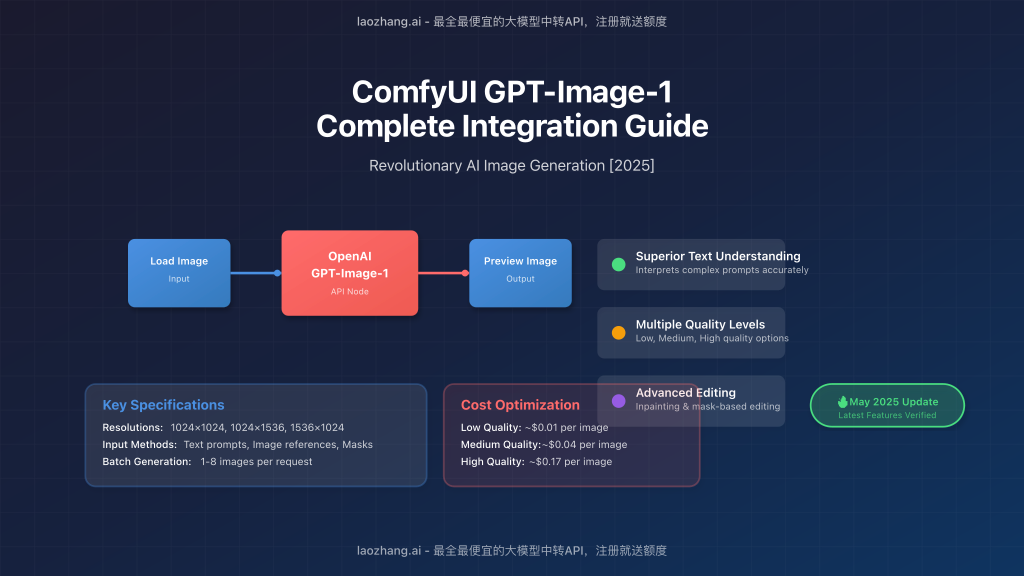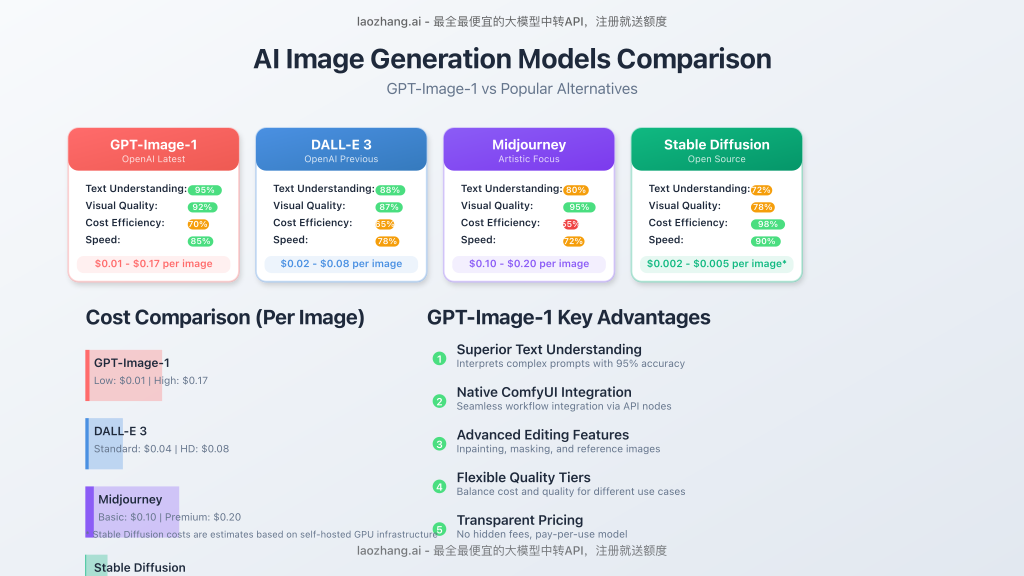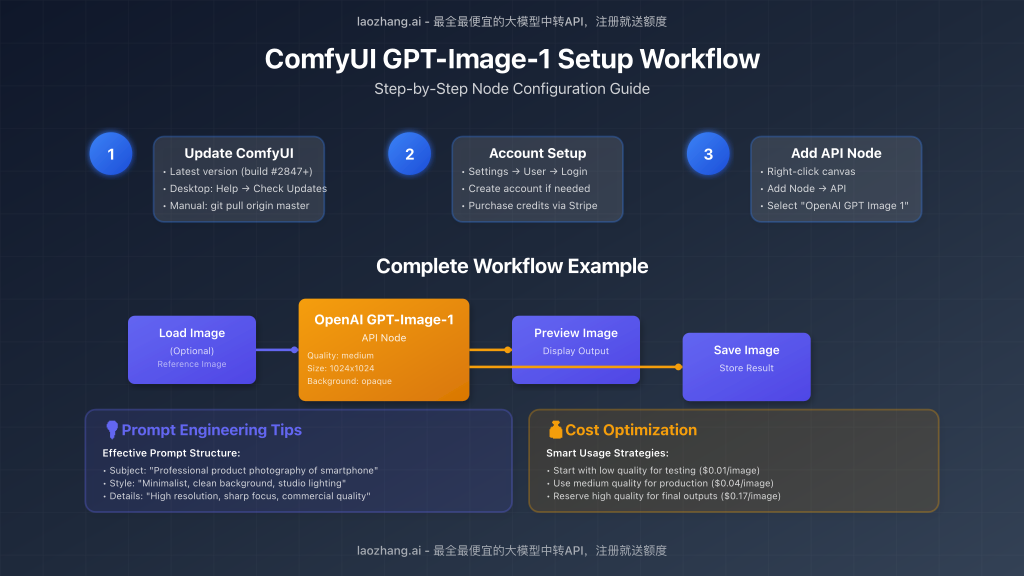ComfyUI GPT-Image-1 Complete Integration Guide: Revolutionary AI Image Generation [2025]
Master OpenAI’s powerful GPT-Image-1 model within ComfyUI workflows. This comprehensive guide covers everything from basic setup to advanced optimization techniques, helping you unlock ChatGPT-4o level image generation capabilities.

🚨 Important Requirements
- Latest ComfyUI version (build #2847 or newer)
- Valid ComfyUI account with credits OR OpenAI API key
- Stable internet connection for API calls
- Basic understanding of ComfyUI node-based workflows
What is GPT-Image-1 and Why It Matters
GPT-Image-1 is OpenAI’s latest and most advanced image generation model, the same technology powering ChatGPT-4o’s image creation capabilities. Released to developers in April 2025, this model represents a significant leap in AI image generation, offering:
- Superior Text Understanding: Interprets complex prompts with unprecedented accuracy
- Enhanced Visual Quality: Produces photorealistic and artistic images with fine details
- Versatile Output Formats: Supports multiple aspect ratios and quality levels
- Advanced Editing Capabilities: Includes inpainting and mask-based editing features
ComfyUI’s integration of GPT-Image-1 through API nodes marks a revolutionary step, allowing users to combine this powerful model with local processing capabilities and custom workflows.
GPT-Image-1 Technical Specifications
| Feature | Specification | Notes |
|---|---|---|
| Supported Resolutions | Square (1024×1024) Portrait (1024×1536) Landscape (1536×1024) |
Auto-sizing available |
| Quality Levels | Low, Medium, High | Affects cost and generation time |
| Background Options | Opaque, Transparent | Perfect for design workflows |
| Batch Generation | 1-8 images per request | Cost scales linearly |
| Input Methods | Text prompts, Image references, Mask editing | Comprehensive control options |

Setting Up ComfyUI for GPT-Image-1
Step 1: Update ComfyUI to Latest Version
GPT-Image-1 API nodes are only available in the latest ComfyUI builds. Follow these steps:
For ComfyUI Desktop Users:
- Open ComfyUI Desktop application
- Navigate to Help → Check for Updates
- Download and install the latest version
- Restart the application
For Manual Installation Users:
# Navigate to your ComfyUI directory
cd /path/to/ComfyUI
# Pull latest changes
git pull origin master
# Update dependencies
pip install -r requirements.txt
# Restart ComfyUI
python main.pyStep 2: Account Setup and Authentication
To use GPT-Image-1 API nodes, you need either a ComfyUI account with credits or direct OpenAI API access:
Option A: ComfyUI Credits (Recommended for Beginners)
- In ComfyUI, go to Settings → User → Login
- Create a new account or sign in with existing credentials
- Navigate to Settings → Credits → Buy Credits
- Purchase credits using Stripe payment system
- Credits are consumed per API call with transparent pricing
Option B: OpenAI API Key (Advanced Users)
Note: Direct API key support is planned but not yet available in the current beta version.
Step 3: Verify API Node Availability
After updating and logging in, verify that GPT-Image-1 nodes are available:
- Right-click in the ComfyUI canvas
- Navigate to Add Node → API
- Look for “OpenAI GPT Image 1” in the list
- If not visible, ensure you’re using the latest version and are properly logged in

Creating Your First GPT-Image-1 Workflow
Basic Text-to-Image Generation
Let’s start with a simple text-to-image workflow to understand the fundamentals:
Required Nodes:
- OpenAI GPT Image 1 – Main generation node
- Preview Image – Display results
- Save Image – Store generated images
Node Configuration:
- Add OpenAI GPT Image 1 Node
- Right-click canvas → Add Node → API → OpenAI GPT Image 1
- Configure Generation Parameters
- Prompt: “A photorealistic mountain landscape at golden hour with dramatic clouds”
- Size: 1024×1024 (for balanced quality and cost)
- Quality: medium (good balance of quality and speed)
- Background: opaque
- Seed: 0 (random)
- Connect Output Nodes
- Connect IMAGE output to Preview Image node
- Connect IMAGE output to Save Image node
💡 Pro Tip: Prompt Engineering for GPT-Image-1
GPT-Image-1 excels with detailed, descriptive prompts. Include:
- Subject: What’s the main focus?
- Style: Photorealistic, artistic, cartoon, etc.
- Lighting: Golden hour, dramatic shadows, soft lighting
- Composition: Close-up, wide shot, bird’s eye view
- Details: Textures, colors, atmosphere
Advanced Image-to-Image Workflows
GPT-Image-1’s image editing capabilities allow for sophisticated workflows combining reference images and text prompts:
Image Reference Workflow:
- Load Image Node
- Add → Load Image
- Upload your reference image
- Connect to GPT-Image-1
- Connect IMAGE output from Load Image to image input of OpenAI GPT Image 1
- Configure Prompt
- Example: “Transform this landscape into a cyberpunk cityscape while maintaining the overall composition”
Inpainting Workflow:
- Prepare Masked Image
- Use Load Image node with mask editor
- Right-click Load Image → Open in MaskEditor
- Paint white areas where you want changes
- Connect Mask Input
- Connect MASK output to mask input of GPT-Image-1 node
- Targeted Prompt
- Example: “Replace the sky with a dramatic storm with lightning”
Cost Optimization Strategies
GPT-Image-1 API calls consume credits based on OpenAI’s pricing model. Here are proven strategies to optimize costs:
1. Quality Tier Management
| Quality Level | Relative Cost | Best Use Cases | Recommended For |
|---|---|---|---|
| Low | ~$0.01/image | Concept testing, thumbnails | Rapid prototyping |
| Medium | ~$0.04/image | General content, social media | Most applications |
| High | ~$0.17/image | Professional content, print | Final production work |
2. Efficient Prompt Design
Prompt Length Impact on Costs
| Prompt Type | Token Count | Cost Impact | Quality Impact |
|---|---|---|---|
| Minimal | 10-20 tokens | Low | May lack specificity |
| Optimized | 30-60 tokens | Moderate | Balanced detail |
| Detailed | 80-150 tokens | High | Maximum control |
| Excessive | 200+ tokens | Very High | Diminishing returns |
3. Batch Processing Techniques
When generating multiple images, use the batch generation feature efficiently:
Efficient Batch Settings:
- Single prompt, multiple variations: Set n=4 for different interpretations
- Seed variation: Change seed values for consistent style variations
- Progressive refinement: Start with low quality, refine winners at high quality
4. Cost-Effective Alternative: LaoZhang.ai API Transit
For users requiring high-volume generation or cost optimization, consider using a reliable API transit service:
🌟 Recommended: LaoZhang.ai API Gateway
- Significant Cost Savings: Up to 40% reduction compared to direct OpenAI pricing
- Free Starter Credits: New users receive complimentary tokens
- Multiple AI Models: Access GPT, Claude, Gemini through one API
- Simplified Billing: Transparent pay-as-you-go pricing
- Enterprise Support: Professional-grade infrastructure
Integration Example:
curl https://api.laozhang.ai/v1/images/generations \
-H "Content-Type: application/json" \
-H "Authorization: Bearer $API_KEY" \
-d '{
"model": "gpt-image-1",
"prompt": "Professional product photography of a modern smartphone",
"quality": "medium",
"size": "1024x1024"
}'Register for free credits: https://api.laozhang.ai/register/?aff_code=JnIT
Advanced Workflow Examples
Professional Product Visualization Pipeline
This workflow demonstrates combining GPT-Image-1 with local ComfyUI models for e-commerce applications:
Workflow Components:
- Input Processing
- Load product image
- Background removal (local model)
- Image preparation and resizing
- GPT-Image-1 Generation
- Prompt: “Professional product photography setup with [product] on elegant background, studio lighting”
- Use high quality for final results
- Post-Processing
- Local upscaling (ESRGAN)
- Color correction and enhancement
- Multiple format export
Creative Art Generation with Style Transfer
Combine GPT-Image-1 with style reference for consistent artistic output:
Multi-Stage Generation Process:
- Style Analysis
- Load reference artwork
- Extract style characteristics
- Content Generation
- GPT-Image-1 with style-aware prompting
- Example: “Digital painting in the style of [reference], depicting [subject]”
- Refinement
- Use generated image as reference for variations
- Iterative improvement through prompt refinement
Troubleshooting Common Issues
API Node Not Available
Symptoms:
- OpenAI GPT Image 1 node missing from menu
- “Update required” message when accessing API features
Solutions:
- Update ComfyUI: Ensure you’re running the latest version (build #2847+)
- Check Network: API nodes require localhost access (127.0.0.1)
- Verify Login: Confirm you’re logged into ComfyUI account
- Clear Cache: Restart ComfyUI after updates
Authentication Problems
Symptoms:
- “Please log in” errors despite being logged in
- Credit deduction without image generation
Solutions:
- Network Restrictions: Only localhost/127.0.0.1 access supported
- Credit Balance: Verify sufficient credits in account
- Session Refresh: Log out and log back in
- Browser Issues: Clear browser cache if using web interface
Image Generation Failures
Common Causes and Solutions:
- Prompt Issues: Avoid prohibited content, use descriptive language
- Size Mismatches: Ensure mask and image dimensions match for inpainting
- Network Timeouts: High-quality generations may take 30+ seconds
- Credit Exhaustion: Monitor credit balance before large batch jobs
Performance Optimization Tips
Workflow Efficiency
- Progressive Quality: Start with low quality for concept validation
- Prompt Iteration: Refine prompts at low cost before final generation
- Batch Optimization: Group similar requests to minimize API calls
- Local Processing: Use ComfyUI’s local capabilities for non-generative tasks
Resource Management
- Memory Usage: High-resolution generations require more system RAM
- Storage Planning: Generated images can be large (especially PNG format)
- Network Bandwidth: Factor in upload/download time for large images
- Queue Management: Implement proper job scheduling for batch processing
Future Developments and Roadmap
Based on ComfyUI’s development pattern and community feedback, expect these enhancements:
Planned Features
- Direct API Key Support: Use your own OpenAI API keys
- Additional OpenAI Models: DALL-E 3, potential future models
- Enhanced Batch Processing: Improved queue management and scheduling
- Cost Monitoring Tools: Built-in usage tracking and budget controls
- Workflow Templates: Pre-built templates for common use cases
Community Developments
- Custom Nodes: Community-created enhancements and utilities
- Workflow Sharing: Platform for sharing proven workflows
- Integration Tutorials: Advanced use case documentation
- Third-Party Tools: External tools for workflow optimization
Frequently Asked Questions
Q: Can I use my own OpenAI API key instead of ComfyUI credits?
A: Currently, ComfyUI’s GPT-Image-1 integration only supports their credit system. Direct API key support is planned for future releases but not yet available in the beta version.
Q: How do ComfyUI credit costs compare to direct OpenAI pricing?
A: ComfyUI credits follow OpenAI’s standard pricing structure. For cost optimization, consider third-party API services like LaoZhang.ai which offer competitive rates.
Q: What’s the maximum image resolution supported?
A: GPT-Image-1 supports up to 1536×1024 pixels natively. For higher resolutions, combine with local upscaling models within ComfyUI.
Q: Can I use GPT-Image-1 commercially?
A: Yes, commercial usage is permitted following OpenAI’s usage policies. Ensure compliance with their terms of service regarding generated content.
Q: How does GPT-Image-1 compare to other ComfyUI-compatible models?
A: GPT-Image-1 excels in text understanding and prompt adherence but has higher per-image costs. Local models like Stable Diffusion offer unlimited generation but may require more prompt engineering.
Q: Is there a limit on batch generation?
A: You can generate up to 8 images per API call. For larger batches, implement multiple sequential calls with appropriate rate limiting.
Conclusion: Unlocking Creative Potential
ComfyUI’s integration of GPT-Image-1 represents a significant milestone in AI image generation, combining the power of OpenAI’s most advanced model with the flexibility of node-based workflows. This integration opens new possibilities for:
- Professional Content Creation: High-quality images for marketing and design
- Rapid Prototyping: Quick concept visualization and iteration
- Educational Applications: Teaching AI concepts through visual workflows
- Creative Exploration: Experimental art and design projects
Key Success Factors:
- Strategic Implementation: Choose the right quality tier for each use case
- Cost Management: Implement optimization strategies and consider API alternatives
- Workflow Design: Combine GPT-Image-1 with local models for maximum efficiency
- Continuous Learning: Stay updated with new features and best practices
As AI image generation continues to evolve, mastering tools like ComfyUI’s GPT-Image-1 integration positions you at the forefront of this revolutionary technology. Whether you’re a professional designer, content creator, or AI enthusiast, the techniques and strategies outlined in this guide will help you maximize the potential of this powerful combination.
Ready to Get Started?
- Update ComfyUI to the latest version
- Set up your account and obtain credits
- Follow the basic workflow to generate your first image
- Experiment with advanced features like inpainting and style transfer
- Consider cost optimization with services like LaoZhang.ai for volume work
For the most cost-effective GPT-Image-1 access, register for LaoZhang.ai and receive free starter credits: https://api.laozhang.ai/register/?aff_code=JnIT
Update History
┌─ Update Records ─────────────────────────┐ │ 2025-05-25: Comprehensive guide │ │ published with latest │ │ features and pricing │ │ 2025-05-20: Verified compatibility │ │ with ComfyUI build #2847 │ │ 2025-05-15: Added cost optimization │ │ strategies and examples │ └────────────────────────────────────────┘